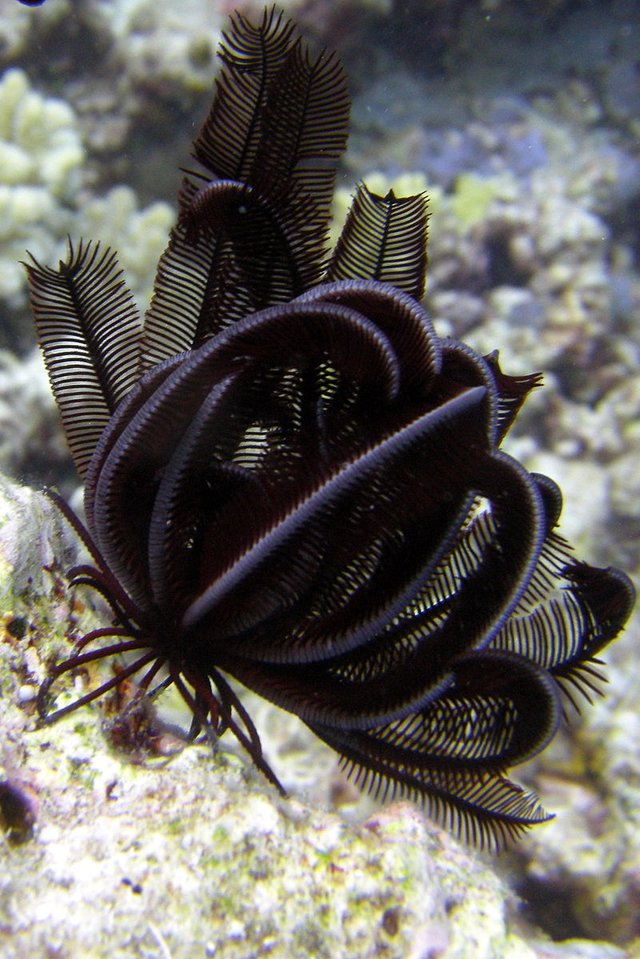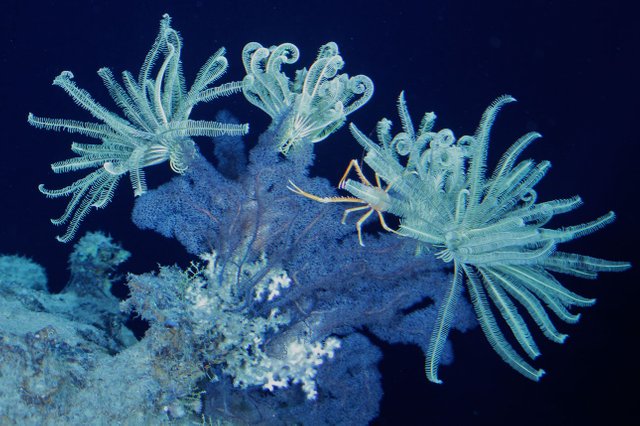Sea Lilies (Crinoidea)
Crinoid on the reef of Batu Moncho Island (near Komodo, Indonesia) (CC BY-SA 3.0)credit
Sea lilies are one of the most beautiful representatives of the ocean fauna. These bright creatures resemble alive coral bunches, although they are actually predators and are not averse to a bite of plankton and small crustaceans.
Long ago the seas were replete with relatives of sea stars and sea urchins - sea lilies.
Their romantic name for these creatures for their similarity with flowers, but in fact the sea lilies have nothing to do with plants. Sea lilies (or Crinoidea) - a class of echinoderms, related to sea urchins and sea stars. Like all echinoderms, marine lilies have a five-ray symmetry of the body, more characteristic of plants (usually animals are characterized by bilateral symmetry).

Crinoideo en Queensland, Australia (CC BY-SA 3.0)credit
Sea lilies can be found in any ocean and at any depth. There are species living at a depth of 10,000 m. Most species (70%) live at a shallow depth of up to 200 m. Especially many lilies in warm latitudes on coral reefs.
The body of the lily consists of a so-called "calyx", which is fixed on the bottom. From the cup rays come up, rising up. The main task of these rays is to filter out small crustaceans from the water and transfer them to the mouth located in the center of the calyx.
The ocean is full of strange creatures that would not have died anywhere except the depths of the sea. Sea lilies (Crinoidea), better known as "feathered stars" or "crinoids," not only look like bizarre living bushes, but also move in the water with the help of smooth uniform movements of their rays.
Long, flexible "hands" are needed by the crinoids not only for movement: with their help, echinoderms can easily catch creeping prey. The length of the rays can reach 1 m. The animal has five, but each beam can branch strongly, forming a lot of "false legs". Equipped with numerous lateral branches (pinnules).
Lilies are passive filterers, which filter out a nutrient suspension from the water. To transport the prey to the mouth, the sea lily uses special rays on the inner, oral side: they are provided with mucous-ciliary ambulacral grooves, through which water with captured plankton falls directly into the mouth.
Sea lilies appeared on the planet about 488 million years ago. During the Paleozoic period, there were over 5,000 species of sea lilies, most of which became extinct. That time was the golden age of all echinoderms, and sea lilies in particular. Fossils of those times abound in the remains of animals, and some limestone layers almost entirely consist of them. Until now, only those lilies that appeared on Earth about 250 million years ago have survived.
Macrocrinus verneuilianus (Shumard, 1855) from the Burlington Limestone (Lower Carboniferous) near Burlington, Iowa. (CC0 public domain)credit
After this, the sea lilies suffered catastrophic losses along with other animals during the largest extinction. Survived only a small number of species subclass Articulata for which were characterized by more flexible hands. At the beginning of the Triassic, the revival of sea lilies began, completely new species appeared that occupied their former evolutionary niches, as well as places that had been freed after the death of some closely related animals. However, the sea lilies never managed to regain their former glory. Modern marine lilies are rare and noticeably different from their ancestors.

Crinoideos anclados a colonia de gorgonia y langosta rechoncha de la familia Galatheidae, 400 m, Roatan, Honduras (CC BY-SA 3.0)credit
Petrified segments of sea lilies - trochites, asterisks and discs with a hole in the center, sometimes joined in columns - have long attracted the attention of people. Polygonal segments of crinoids in the form of stars, the British called "stone stars" and made various assumptions about their relationship with the heavenly bodies. The first written mention of them belongs to the English naturalist John Ray in 1673.
In 1677, his compatriot, naturalist Robert Plot (1640-1696), admitted that the beads of St. Cuthbert, Bishop Lindisfarne, were made from the segments of these animals. On the coast of Northumberland, these fossils are called - "the beads of St. Cuthbert." Sometimes trochites resembling gears are described in the press as "details of alien machines" created by aliens hundreds of millions of years before the appearance of man.
In my opinion, these are very beautiful creatures behind which one can observe both the burning fire, the flow of water and the work of another person. I suggest you enjoy one more video.
I see this time you have put much more effort in your post! :)
The SteemStem community needs active members that produce quality material around here.
Just keep in mind that in order to be supported you need to engage, read other steemstem posts, comment and upvote other authors of the community as well ;)
You can have a look around the tag and find a couple of authors you may like :)
It turned out to be not difficult with such a mentor as you..🙂Thank you for your mentoring! I read only the trumpman. Can you recommend more authors who write with this tag? Do I need to become a follower of these authors? Or something else?
They are so many, but mobbs, greenrun and samminator, are a few examples of people who write under the #steemstem tag.
If you want to become a part of the community you need to:
I think I covered almost everything :)
Thank you for your advice! I remember mobbs! Trumpman organized a beer week for us two months ago.
Don't mention it... And you can ask me about anything anytime :)
Fantastic post! Such beauty lives within the ocean working in unity
You're right! These creatures are beautiful. The movement of these creatures sends me into a state of hypnosis.